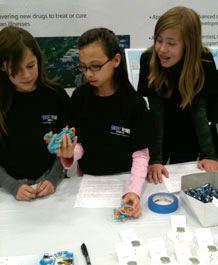

Scripps Research SMART Teams Present Work at High Tech Fair
By Mika Ono
Students participating in the high school SMART team program at The Scripps Research Institute showcased their work at the San Diego High Tech Fair on Tuesday, presenting posters and molecular models at the Del Mar Fairgrounds to thousands of parents and students from around the region.
"They were a big hit," said Marisela Chevez, the Scripps Research science outreach coordinator who spearheaded the SMART team the program in San Diego with Ange Mason of the University of California, San Diego (UCSD) Super Computer Center. "All the hard work the students did throughout the year showed."
The program—called "Students Modeling a Research Topic or "SMART" for short—was originally developed at the Milwaukee School of Engineering to provide students with the opportunity to learn more about science on their own time, after school and on weekends.
Now in its second year in San Diego thanks to efforts at Scripps Research and the UCSD Super Computer Center and a grant from the Howard Hughes Medical Institute, the number of schools participating has increased to six. New to the SMART team program are Lutheran High School of San Diego and Francis Parker School. Returning are teams from El Capitan High School, Lincoln High School, Arroyo Paseo Academy, and Audeo Charter, now called North San Diego Girls Cooperative. Some students from these schools opted to participate for their second year.
In the SMART team program, students delve in depth into a research topic over the course of an academic year, with the support and input of a teacher from the team's school, SMART team program directors, and laboratory scientists. The students' activities center around a specific molecule that is important to the scientists' research.
Participants started the year by learning the basics of protein structure and folding, crystallography, and molecular modeling. In November, each team was paired with a volunteer lab from Scripps Research. "Thanks so much to the mentors in the Wilson, Kuhn, Wright/Dyson, Stout, and Stevens groups for volunteering to work with the students," said Chevez.
Over the winter months, the teams met with the scientists from "their" lab, learned about the lab's work, and created posters explaining their molecule. The teams also worked on creating physical models of their molecule using cutting-edge molecular modeling technology, available from the Scripps Research Olson lab, to give to their SMART team teachers and scientific mentors. The students used software called RasMol to design their models, which were later "printed" out in eight to 12 inch structures that can be examined up close and passed from person to person.
"Marisela has brought together a great team of people to guide the teams through various parts of the project," said David Goodsell of the Olson lab, who is scientific advisor for the San Diego initiative. "I have been helping with the design of models. As in the past years, the students have done a great job with their designs. I'm always amazed at the creativity they put into their designs—each team comes up with something unique."
The students are currently in the final phase of the program, which involves sharing their work with each other and with the community. In addition to showing their work at the High Tech Fair—which was also attended by representatives of the Olson lab—the SMART teams will participate in presentations on the Scripps California campus on Saturday, March 20, and at the San Diego Science Festival on Saturday, March 27.
Susan Moerder, a teacher and SMART team leader at the Francis Parker School, said, "I have students on my SMART Team who range in all academic levels. The program has been beneficial for all of them. My top student has had the opportunity to work closely in the lab with our mentor, Dr. Gira Bhabha, while my students who typically struggle academically have found an area where they can shine. Whether it was designing the model, the poster, or the power point for their presentation, every student on the team had a job to do and had the chance to show their talent. This has been a great experience for all of us and I look forward to continuing our participation in future years."
For more information on the SMART team program, contact Chevez, at mchevez@scripps.edu or (858) 784-2171.
Send comments to: mikaono[at]scripps.edu

Models created by SMART team participants help explain how specific molecules work.
